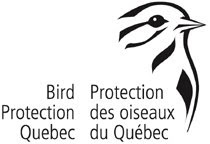Conditions were almost summer-like for the twenty birders who started out the day with a walk along the shoreline and then inland to Lac de la Sauvagine. Later we took the trail to La Grande Baie. Sunny cloudless skies, light breezes and temperatures pushing 22°C had us hoping for a great early spring day of birding. But as Pierre Bannon pointed out on OrnithoQuebec this morning the system which is giving us this weather is also causing a "block" in the North-eastern United States which is keeping many migrants pinned down to the south. All this to say that we had to work hard for our birds and many of those listed below were only heard and not seen and even then by only one or two of our participants. Bird of the day was considered to be the Pine Warblers which were calling in several locations throughout the first section of our trip. They were numerous enough that we began to question our ID and had to track a few down to be sure. A group of Red-breasted mergansers flying by at close range was notable as were a pair of Caspian Terns over the marsh at La Grande Baie ( with a pair of Common Terns nearby by for a nice size comparison), and the close fly-by of an Osprey as we waited in the parking lot to start the trip.
In the category of non-avian sightings it was Northern Water Snakes that made the biggest impression. We sighted at least seven or eight including a small group of them who turned us all into "voyeurs" as we watched the threesome doing what animals do best in spring. Such was their amorous intensity that they paid no attention to the humans watching from the boardwalk and clicking away with cameras from a distance of no more than four feet. One even seemed to be giving little chirps of ecstasy but alas more likely it was just being squeezed a little too tightly by a larger rival! A beaver quietly grooming itself ten feet from the boardwalk and two deer that barely budged off the trail as we passed were also highlights.
Many thanks to everyone who came out on such a glorious spring day. Our complete list of 63 species heard or seen by at least one member of the group follows. - Wayne
Canada Goose - 200, Wood Duck -15, Gadwall - 7, Mallard -10, Teal sp. -6, Northern Shoveler - 2, Hooded Merganser - 6, Red-breasted Merganser - 10, Pied-billed Grebe - 1, Double-crested Cormorant - 5, Great Blue Heron - 8, Great Egret - 2, Turkey Vulture - 4, Osprey - 1, Cooper's hawk - 2, Red-shouldered Hawk - 2 Broad-winged Hawk - 2, Killdeer - 1, Spotted sandpiper - 3, Wilson's Snipe - 1, Ring-billed Gull - 3, Caspian Tern - 2 ommon Terns - 5, Yellow-bellied Sapsucker - 10, Downy Woodpecker -6, Hairy Woodpecker - 1, Northern Flicker - 4, Pileated Woodpecker - 4, Eastern Phoebe - 3, Great Crested Flycatcher - 2, Blue-headed Vireo - 2, Warbling Vireo - 2, Blue Jay - 1, American Crow - 15, Common Raven - 3, Purple Martin - 1, Tree Swallow - 20, Black-capped Chickadee - 8, Red-breasted Nuthatch - 3, White-breasted Nuthatch - 3, Marsh Wren - 3, Hermit Thrush - 4, American Robin - 8, European Starling - 15, Yellow Warbler - 4, Magnolia Warbler - 1, Yellow-rumped Warbler - 4, Black-throated Green Warbler - 1, Pine Warbler - 6, Black & white warbler 1, Ovenbird - 2, Chipping Sparrow - 10, Song Sparrow - 6, Swamp Sparrow - 8 ,White-throated Sparrow - 8, Dark-eyed Junco - 2, Northern Cardinal - 2, Red-winged Blackbird - 24, Rusty Blackbird - 5 ,Common Grackle - 12 ,Brown-headed Cowbird - 4 ,Purple Finch - 3, American Goldfinch - 3
Bernache du Canada,- 200, Canard branchu -15, Canard chipeau - 7, Canard colvert -10, Teal sp. -6, Canard souchet - 2, Harle couronné - 6, Harle huppé - 10, Grèbe à bec bigarré - 1, Cormoran à aigrettes - 5, Grand héron - 8, Grande aigrette - 2, Urubu à tête rouge - 4, Balbuzard pêcheur 1, épervier de Cooper - 2, Buse à épaulettes - 2 Petite Buse - 2, Pluvier kildir - 1, Chevalier Grivlé - 3 Bécassine de Wilson 1 -, Goéland à bec cerclé - 3 Sterne caspienne - 2, Sternes pierregarin -5, Pic maculé - 10, Pic mineur -6, Pic chevelu - 1, Pic flamboyant - 4, Grand Pic - 4, Moucherolle phébi - 3, Tyran huppé - 2, Viréo à tête bleue - 2, Viréo mélodieux - 2, Geai bleu - 1, Corneille d'Amérique - 15, Grand Corbeau - 3, Hirondelle noire 1, Hirondelle - 20, Mésange à tête noire - 8, Sittelle à poitrine rousse - 3, Sittelle à poitrine blanche - 3, Troglodyte des marais - 3, grive solitaire - 4, American Robin - 8, Étourneau sansonnet - 15, Paruline jaune - 4, Paruline à tête cendrée- 1, Paruline à croupion jaune - 4, Paruline à gorge noire - 1, Paruline des pins - 6, Paruline noir et blanc - 1, Paruline couronnée, Paruline couronnée - 2, Bruant familier - 10, Bruant chanteur - 6, Bruant des marais - 8, Bruant à gorge blanche - 8, Junco ardoisé - 2, Cardinal rouge -2, Carouge à épaulettes- 24, Quiscale rouilleux - 4, Quiscale bronzé - 12, acher à tête brune - 4, Roselin pourpré - 3, Chardonneret jaune - 3





No comments:
Post a Comment